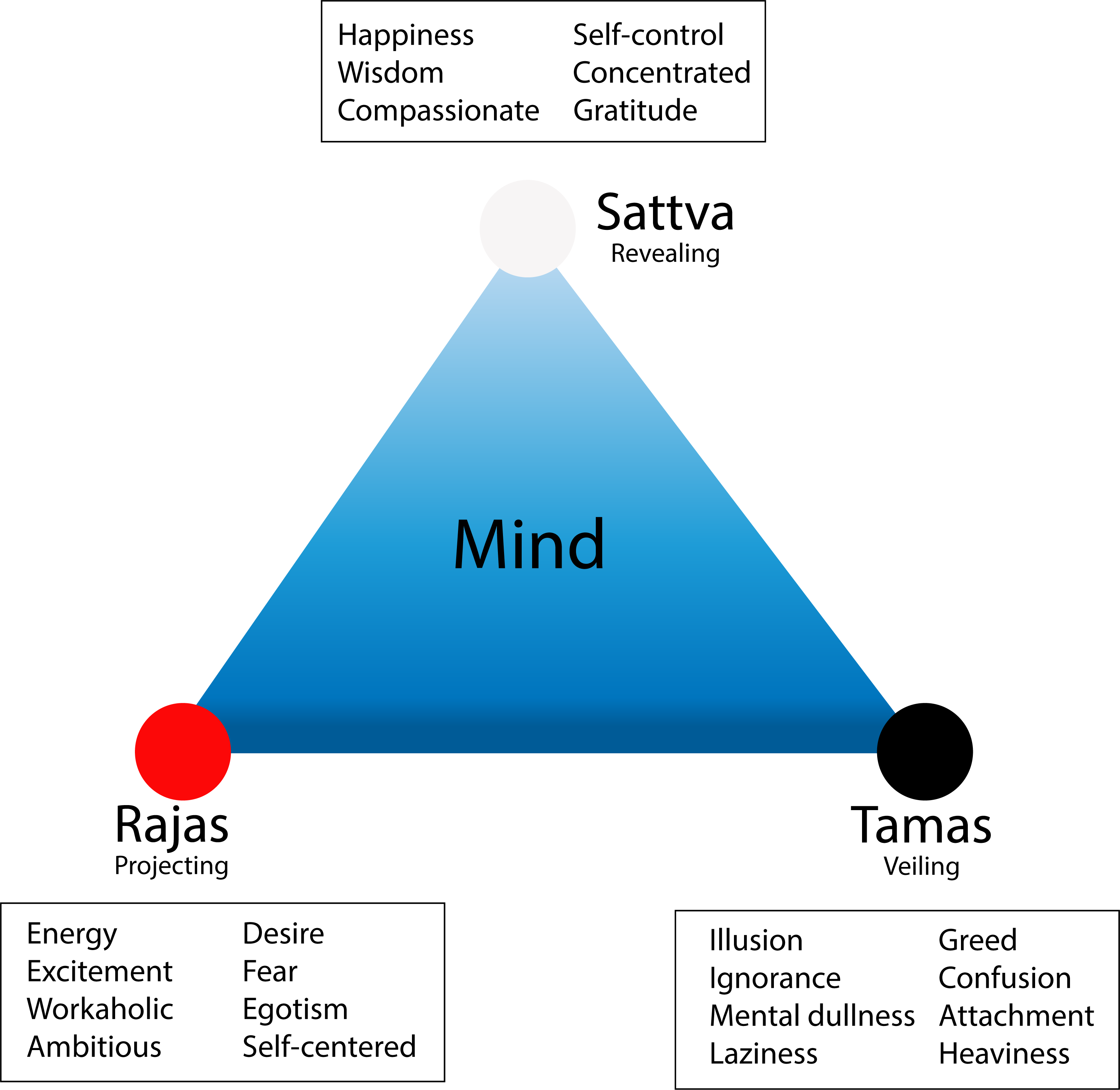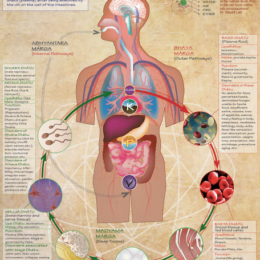Dosha aggravation by itself doesn’t develop into a disease. Doshas must find weak dhātus to lodge into. Six stages of disease manifestation are described in Ayurveda. These stages are called Ṣaḍ Kriyā Kāla (Ṣaḍ -six, Kriyā – action/treatment, Kāla – stage).

The importance of knowing these stages:
Āyurveda’s emphasis is on prevention. It is easier to prevent the disease or cure it if detected at the earlier stages. At each of the following stages, different measures can be taken to reverse the process and prevent manifesting the disease.
Usually, these six stages are also understood as clubbed into two phases viz. accumulation and aggravation. In that case, aggravation includes all the five stages after accumulation. These six stages are also called ‘Six occasions of therapy’ (Ṣaḍ kriyā kāla) as an intervention in the form of therapy can be done at any of these stages. Early intervention may arrest the progress of the disease, and subsequent phases can thus be checked.

1. Sañcaya (Accumulation)
This is the first stage of saṃprāpti. In this stage, doṣas accumulate in their original locations.
Vāta accumulates in pakvāśaya (colon)
Pitta in pittāśaya (small intestine)
Kapha in āmāśaya (stomach)
The symptoms at this stage are :
Vāta: Gas, bloating, distension
Pitta: Yellowish skin, things look yellow
Kapha: Heaviness, lethargy, loss of appetite, feeling of cold
If these symptoms are present, the doṣas have started to accumulate and the disease process has begun. In the Sañcaya stage, doṣas increase quantitatively. At this stage, the body tries to get into balance by desiring foods with opposite qualities. This is called viparīta guṇa icchā.
In Sañcaya the body craves for
Vāta: Warm, moist, heavy foods
Pitta: Cool, dry, and heavy foods
Kapha: Warm, dry, and light foods.
Warning
2. Prakopa (Aggravation)
At this stage, the accumulated doṣas react with āma and become sāma doṣas. Āma ferments and becomes liquid. This is called āmaviṣa (toxin). Due to the fluid consistency of āma, sāma doṣas start overfilling in the original sites. At this stage, there is some movement.
Signs at Prakopa
Vāta: Pricking pain, movement of gases in the colon, intense desire for coldness
Pitta: Sour belching, thirst, and burning in the stomach
Kapha: Nausea, aversion to food
At this stage doṣas increase qualitatively.
In the prakopa stage, sāma doṣas should be removed by cleansing (inducing vomiting, diarrhea, or enema) and then palliated by a balanced diet.
For Vāta: Sweet, sour, salty, warm, moist, heavy foods
For Pitta: Sweet, astringent, bitter, cool, dry, and heavy foods
For Kapha: Pungent, astringent, and bitter, warm, dry, and light foods.
3. Prasara (Spread)
If doṣas are not controlled at this stage, they further aggravate and start flowing into different srotas. This is the third kriyākāla. Here, aggravated doṣas start flowing all over the body. Wherever they find the weak link (blockage or weakness), the disease process starts there. Just as dough in a container gets fermented and rises and overflows from it, so is the state of Prasara.
The signs at this stage are:
Vāta: Intense movement of gas and moving in the upward direction, the body becomes stiff
Pitta: Intense thirst, dry mouth, inflammation of mucous membrane in the mouth, burning sensation in the body
Kapha: Increased nausea, vomiting, excessive salivation, loss of taste
At this stage Doṣas increase by action.
Hence, they are treated by cleansing and counteracting herbs.
For Vāta: Herbs like cumin, asafetida, ajwain
For Pitta: Herbs like licorice, āmalakī, drākṣā (grapes)
For Kapha: Herbs like dry ginger, black pepper, long pepper
The first three stages are mainly related to Doṣa vṛddhi alone. Hence, eradicating aggravated doṣas at these stages is a great preventive measure.
4. Sthānasaṃśraya (Localization)
This is an important stage of saṃprāpti. At this stage, doṣas find weak strotas (channels) and react with associated dhātu/s.
An amalgamation of doṣa and dhātu will produce a different kind of biochemical compound. Here attributes of doṣa and dhātu totally change because of this abnormal, toxic compound. This is known as doṣa-dūṣya-sammūrchana. Due to this, dhātus lose their intelligence, and integrity and show signs of imbalance.
5. Vyakti (Manifestation)
Is when the classical manifestation of a particular disease actually occurs. It is only when a condition attains this level that it is termed as a disease like prameha (diabetes), arbuda (tumors), granthi (cysts), arśas (hemorrhoids), etc. By this time the doṣas and
dūṣyas might have attained a more complex stage and the prognosis would have become kṛcchra sādhya.
In this phase, the doṣa expresses itself as a disease. The signs and symptoms of the disease are produced in this stage.
When Doṣa-dūṣya-sammūrchana completes, the classical signs called “cardinal signs” of the disease appear. The diagnosis is certain from these signs.
6. Bheda (Differentiation)
The disease is further diversified to show doṣa and dhātu involvement. Diversification/differentiation is the last stage of the disease process.
E.g.,
Vāta arthritis – there will be severe pain, coldness, stiffness, dry skin, and constipation.
Pitta arthritis – there will be fever, burning sensation, red swollen joints, and loose motions.
Kapha arthritis – there will be swelling, pitting edema, phlegm, and congestion.
The First three stages are preventive, the last three are curative.
When Vāta is involved in Saṃprāpti, there will be degeneration of tissues due to dryness, e.g., muscle wasting.
When Pitta is involved, there will be changes due to heat, like pus-forming infections.
When Kapha is responsible, there will be water retention, congestive changes due to excess moistness.
The mental expressions of doṣa imbalances:
In Vāta diseases, there is fear, sadness, and nervousness.
In Pitta diseases, there is irritability, anger, and sensitivity.
In Kapha diseases, there is attachment, grief, excessive sleep, and laziness.
First three phases are preventative, last three must be cured
Three-phase dynamics
Seasonal Cyclic Changes of Humors according to the Doshas
Vata
Late winter: No Change
Spring: No Change
Summer: Accumulation
Rainy: Aggravation
Autumn: Subsidence
Early Winter: No Change
Pitta
Late winter: No Change
Spring: No Change
Summer: No Change
Rainy: Accumulation
Autumn: Aggravation
Early Winter: Subsidence
Kapha
Late winter: Accumulation
Spring: Aggravation
Summer: Subsidence
Rainy: No Change
Autumn: No Change
Early Winter: No Change





